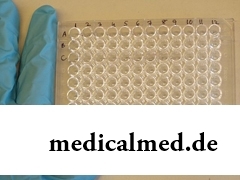





Enzyme immunoassay
 The enzyme immunoassay is carried out when there are difficulties with diagnosis if the patient has a genetic predisposition to some diseases to estimate efficiency of treatment. The analysis reveals antigens and antibodies, characteristic of certain activators, to them. Reaction of interaction of antigen with a specific antibody as a result of which the complex incorporating the special tag changing coloring of the studied sample under the influence of reagent is formed is the cornerstone of an enzyme immunoassay of blood. Intensity of coloring gives the chance to judge existence of the antibodies or antigens characteristic of a certain infection, and already determine their quantity by the equipment.
The enzyme immunoassay is carried out when there are difficulties with diagnosis if the patient has a genetic predisposition to some diseases to estimate efficiency of treatment. The analysis reveals antigens and antibodies, characteristic of certain activators, to them. Reaction of interaction of antigen with a specific antibody as a result of which the complex incorporating the special tag changing coloring of the studied sample under the influence of reagent is formed is the cornerstone of an enzyme immunoassay of blood. Intensity of coloring gives the chance to judge existence of the antibodies or antigens characteristic of a certain infection, and already determine their quantity by the equipment.
Antigens call alien substances which cause immune defense reaction in an organism – specific proteins (immunoglobulins) are produced. For each activator there is the set of antigens, and reaction of immunity to them is also specific. The main material for the analysis is blood from a vein.
The enzyme immunoassay of blood gives the chance with high precision to reveal the latent diseases which are at an early stage, to inform the doctor on the general condition of the patient and on risks of development of pathologies, on a condition of reproductive health. Carry out the analysis for diagnosing of viral diseases: herpes, hepatitis, a cytomegalovirus, Epstein-Burra's virus etc., infections which are transmitted sexually: gonorrhoeas, ureaplasmas, a hlamidoza, mycoplasmas, trichomonads, syphilis, for definition of a hormonal background, diagnosis of cancer diseases and an immunodeficiency, identification and treatment of allergies.
For carrying out the analysis except blood it is possible to take also cerebrospinal fluid, amniotic waters, vitreous contents.
The analysis assumes use of group of ELI-tests:
- ELI-V - the test allowing to make the conclusion about a condition of immune system;
- ALES - Dia - the test defining a condition of endocrine system. With its help diagnose diabetes of the first and second types;
- ALES - the N-complex-12 informing on a state peripheral and central nervous systems;
- ALES - the Anchor - test 12, the analysis estimating the condition of heart and vessels giving an assessment of risk of development of a stroke, heart attack;
- ALES-Vistsero-16 do for assessment of the general condition of the patient. This test provides diagnosis on 16 indicators: intestines, nervous system, myocardium, kidneys, immune system, liver, stomach, etc.;
- ALES - the P-complex-12 do for assessment of reproductive ability of an organism;
- ELI-ZhKT-12 – the analysis estimating a condition of a GIT and giving the chance to provide risk of development of pathologies;
- ELI-HGCH-AFS the test, reveals disturbances of reproductive health.
Method of an enzyme immunoassay
In medical practice three methods of an enzyme immunoassay are most often applied: indirect, straight line and sendvich-type.
 The indirect method of the analysis is that at its first stage on the polystyrene tablet antigen to which add a sample with antibodies, specific to it, is occluded. The complexes formed as a result of reaction are analyzed by means of the anti-specific antibodies containing a special tag.
The indirect method of the analysis is that at its first stage on the polystyrene tablet antigen to which add a sample with antibodies, specific to it, is occluded. The complexes formed as a result of reaction are analyzed by means of the anti-specific antibodies containing a special tag.
The direct method of an enzyme immunoassay is based that the marked antibodies add to sorbed antigen at once.
The analysis of sendvich-type is similar in the principle of performance to an indirect method, but on the tablet antibodies, but not antigen are occluded.
Interpretation of an enzyme immunoassay
When the infection is primary, in blood find antibodies – class M immunoglobulins. Interpretation of an enzyme immunoassay in which there are data on these antibodies lets the attending physician know that it is necessary to carry out treatment.
If the enzyme immunoassay of blood or other biological liquid found immunoglobulin G, it means that the specific activator in an organism already was earlier, to it antibodies managed to be developed and treatment is not required. If the analysis showed existence of antibodies and a class M, and class G, so the chronic disease passed into an acute stage and demands treatment.
In interpretation of an enzyme immunoassay except the instruction on types of the found antibodies, there is information on their quantity therefore for more detailed explanations and appointment it is necessary to address the specialist who gave the direction on the analysis.
At regular visit of a sunbed the chance to develop a carcinoma cutaneum increases by 60%.

The popular expression "run from a heart attack" became the motto of the people supporting active lifestyle. Moreover, run became peculiar...
Section: Articles about health
For the city dweller the fitness is the most convenient sport. It is enough to acquire the subscription to the gym to get access to various apparatuses and an opportunity to train under the leadership of the experienced consultant. Many consider fitness on...
Section: Articles about health
To look healthy and means well-groomed not only to be pleasant to people around, but also to feel strong, sure and taken place. Specialists in the field of cosmetology quite often note that not all women are able to look after face skin. Many women incorrectly apply cosmetics, ineptly use various procedures, without having exact information on their real influence and dividing numerous delusions about it. All this not the best...
Section: Articles about health
The varicosity has familiarly many, statistically, this disease more than a half of all adult population. As...
Section: Articles about health
We live during an advertizing era. Daily each person receives a solid portion of persuasive councils about what to eat to be healthy and successful. Products about which we will talk today are combined by the following circumstance: all of them are positioned as most...
Section: Articles about health
Some people consider what for medicine of the 21st century of secrets in the field of health of the person almost does not exist. It absolutely not so. The more answers scientists receive, the more the most difficult questions are raised for them by life. Besides, there are diseases which are not explained with science in any way of which existence people know for 100-150 years. These diseases meet not so often, but from some of them nobody is insured....
Section: Articles about health
Many of us, probably, noticed more than once that from intellectual loadings at some point the brain as though "overheats" also "assimilation"...
Section: Articles about health
Tuberculosis – a serious infectious disease which development is caused by mycobacteria (Koch's bacilli). The illness is known from an extreme antiquity. Long time fight against it was considered as ineffective. Quite often the disease affected the whole families, and mortality from it was very much...
Section: Articles about health
Summer in the heat. Many are going to spend vacation abroad. Travelers the tender seas, rest on beaches wait, for sightseeing, campaigns on natural and cultural reserves. But, unfortunately, on vacation also problems with health can wait for us. On a foreign trip it is possible to face also diseases which not only will spoil long-awaited issue, but also will force to be treated within long months after its termination. To be insured completely from troubles of it a sort...
Section: Articles about health
What is in our understanding weeds? It plants which are considered to be suitable only for compost pits and feeding жи...
Section: Articles about health
So, you resolved to lose weight. And now you try to understand what to begin with: from exercise stresses or a diet? And how to make that process of weight loss did not give you an inconvenience, and, on the contrary, brought joy?...
Section: Slideshow
Cold, puffiness of a nose, itch, the watering eyes - characteristic symptoms of the allergic rhinitis resulting from hit of allergens (pollen, house dust, hair of animals, etc.) on a mucous membrane of a nose. Unpleasant feelings often give trouble, serving as the reason of a headache, an acrimony, sleep disorders, and in certain cases and the states close to a depression. How to get rid of undesirable satellites of a disease if near at hand there are no antiallergic...
Section: Articles about health
Hemorrhoids – extremely widespread disease. Periodically arising inflammations and bleeding of hemorrhoidal nodes пр...
Section: Articles about health
The state of health of the person in many respects depends on food. The organism will well function if during food it receive only useful substances, necessary vitamins and microelements. In this case there will be no problems with digestion, with лишн...
Section: Articles about health
Sugar - the digestible refined product which is not of special value for an organism of the modern person. The use of sugar in food is based rather on the psychological dependence caused by desire to indulge itself with something tasty, and further and the biological, caused need of an organism for glucose as a result of big emissions of insulin in blood. Such circulation of insulin and glucose with continuous increase in portions of sugar is rather offensive and can become the reason for a narusha...
Section: Articles about health
All know that self-treatment is dangerous. However absolutely it is almost impossible to do without it. Rate of modern life not on...
Section: Articles about health
History of cultivation of a buckwheat contains more than five thousand years. Grain which is received from this plant is used for preparation of porridges, soups, baked puddings and puddings, do flour which is one of the main ingredients of the noodles popular in of it...
Section: Articles about health
At this plant there are a lot of names: tuberiferous sunflower, Jerusalem artichoke, solar root, earth pear. Contrary to popular belief, it is not an exotic plant at all. The wild girasol grows in a midland of Russia practically everywhere: at the edges of roads, to slopes of ravines, on heathlands. Also several cultural versions different from wild plants are removed by larger and juicy root crops....
Section: Articles about health
Dietary supplements (dietary supplements) for the last decades were so thoroughly included into our life that, apparently, it is already impossible on...
Section: Articles about health
Epilepsy is one of widespread neurologic diseases. Parents, whose children suffer from this illness, should face rumors and delusions, many of which remained since the Middle Ages....
Section: Articles about health
The climax, or menopause is the normal process of the termination of genital function of the woman which is followed by serious hormonal changes in an organism. Usually the menopause begins at the age of 50-55 years, but characteristics of this process are very individual. Factors of earlier approach of a climax are irregular sex life, numerous abortions, addictions, existence of endocrine, autoimmune and gynecologic diseases, frequent stresses and excessive hobby of diets...
Section: Articles about health
Memory is an ability of the central nervous system to fix, keep and as necessary to reproduce information on knowledge...
Section: Articles about health
Life does not indulge the modern woman special emotional comfort and carelessness. The fatigue, troubles at work, misunderstanding in a family and various illnesses immediately affect a condition of hair and skin. And to look safe and attractive so хоч...
Section: Articles about health
Musicotherapy – a treatment method which caused and causes a set of a controversy concerning its efficiency. However the facts are relentless: during the numerous researches curative impact of music on an organism was scientifically confirmed. Since then in a number of the countries the technique is included complex therapy of diseases of cardiovascular and respiratory system, dorsodynias and a backbone, psychosomatic disturbances and many other illnesses. The musicotherapy in a pedi is especially widely applied...
Section: Articles about health
The healthy nutrition is the invariable principle of health and good health for long years of the woman. Nevertheless, in рацио...
Section: Articles about health
Coffee - the tonic loved by many for the invigorating aroma and deep taste. Having the stimulating effect, coffee increases working capacity, promotes concentration of attention, fights against drowsiness and improves mood. Statistically, about 30% of inhabitants...
Section: Articles about health
When overcomes feeling of hunger, and an opportunity to have dinner fully is absent, having a snack − the meals, small on volume, stabilizing sugar level in blood comes to the rescue. The relation of nutritionists to having a snack more often negative, but only because as snack people choose the most caloric products with the increased amount of "bystry" carbohydrates: cookies, rolls, chips, candies. Nevertheless, the advantage of having a snack is obvious to weight loss: the person avoids strong feeling of hunger...
Section: Articles about health
